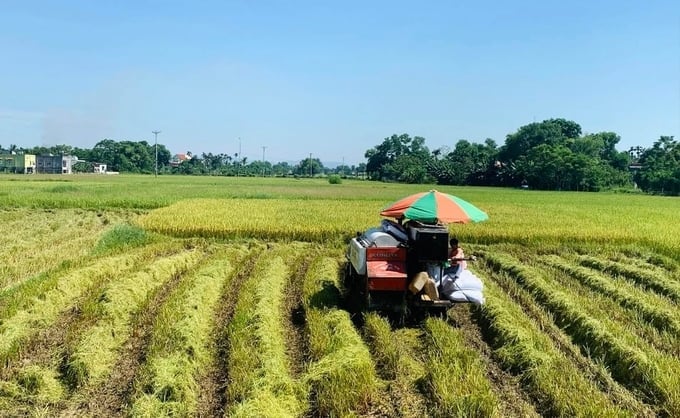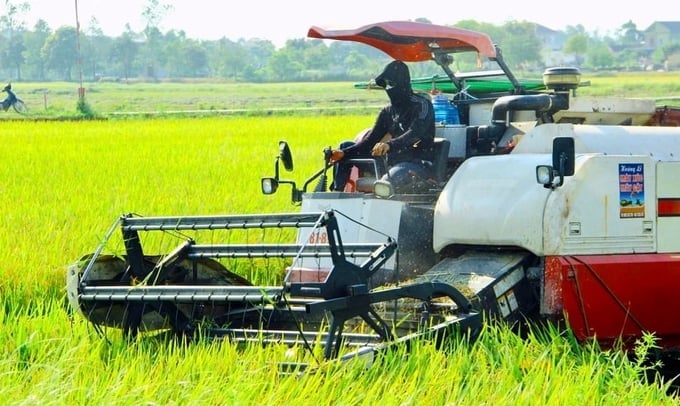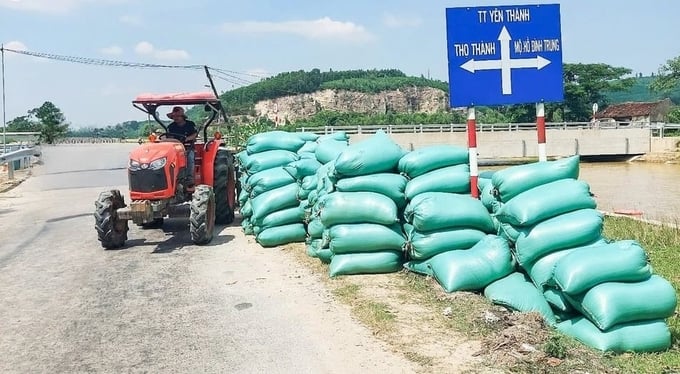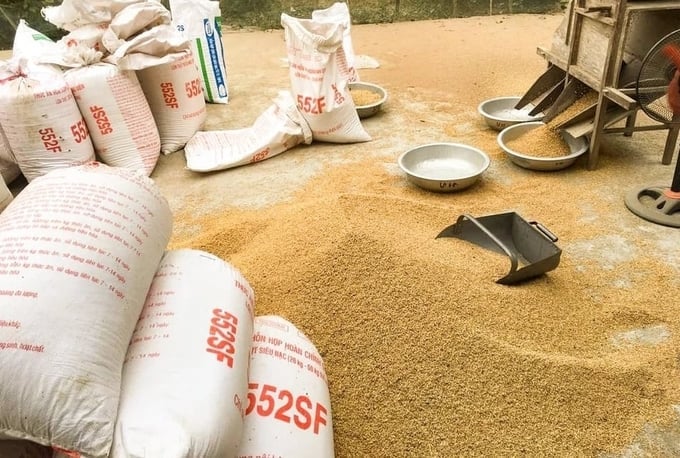June 21, 2025 | 02:09 GMT +7
June 21, 2025 | 02:09 GMT +7
Hotline: 0913.378.918
June 21, 2025 | 02:09 GMT +7
Hotline: 0913.378.918
The summer-autumn crop of 2023 in Nghe An province has been assessed to be a production season fraught with difficulties, primarily due to severe and prolonged drought and heat waves. From the beginning of the year until the start of the crop, the exceptionally low rainfall has depleted water reserves in all reservoirs and streams, leaving many reservoirs at critically low levels. There were forecasts of a severe drought in the early months of the crop, prompting Nghe An province's Department of Agriculture and Rural Development to advise the Nghe An Provincial People's Committee to aim for planting 58,000 hectares of summer-autumn rice, which is 3,000 hectares less compared to previous years.

Rice farmers in Quynh Luu district harvesting the late-autumn crop. Photo: Phu Huong.
Previous summer-autumn rice crops in Nghe An province were either lost due to pest outbreaks or poor yield as a result of heavy rains and typhoons during the monsoon season after September 10 each year. In contrast, this year's summer-autumn crop faced a severe and prolonged drought at the beginning of the season, rendering insufficient water for sowing. Towards the end of the season, there was excessive sunshine with no rain. Additionally, no production areas experienced crop failure due to factors such as monsoon rains, pests, or diseases, as seen in previous summer-autumn rice crops.
Yen Thanh, a district with an annual summer-autumn rice production area of approximately 12,000 hectares, primarily relies on an irrigation system from the Do Luong Reservoir. However, this year's summer-autumn crop witnessed an extremely severe drought, causing over 1,000 hectares of rice to lack sufficient water for cultivation and forcing farmers to switch to other crops.
Consequently, Yen Thanh district only planted over 11,000 hectares for this year's summer-autumn crop. Most notably, 3,400 hectares of rice in low-lying areas were planted in advance to allow for flood-ready harvesting. These areas were harvested before September 5, while the remaining were all harvested before September 10.

Nghe An province's late-autumn rice crop was harvested successfully, without damage due to storms as seen in previous late-autumn rice crops. Photo: Phu Huong.
Mr. Le Van Hong, Head of Agriculture and Rural Development in Yen Thanh district, explained that achieving high yields in this year's summer-autumn crop was exceptionally challenging due to the severe drought. After sowing, rice farmers had to wait until they had sufficient water for transplanting. As a result, a significant portion of the summer-autumn crop was planted with older seedlings, leading to reduced yields. Only 15 to 20% of the rice fields near the irrigation channels had sufficient early water supply and were sown in a timely manner, resulting in yields of 60 to 62 quintals per hectare.
At the conclusion of this summer-autumn crop, Yen Thanh district produced approximately 53 quintals per hectare, which is slightly lower than the previous year by nearly 1 quintal per hectare. The prolonged heatwaves and drought, coupled with strong southwest winds, increased atmospheric evaporation, and led to the loss of nitrogen into the air. Consequently, additional fertilizer was applied, to relatively low effectiveness. However, due to the high rice prices in this year's summer-autumn crop, farmers still managed to achieve reasonable profits and remained optimistic.

Traders visit every hamlet to purchase rice from farmers at very high prices. Photo: Thanh Phuc.
Ms. Nguyen Thi An from Quynh Lam commune, Quynh Luu district, shared that her family cultivated five sao of rice. After harvesting and drying, they managed to produce 1.1 metric tons of rice, with an average yield of 2.2 quintals per sao (equivalent to 44 quintals per hectare). This yield was slightly lower compared to the previous summer-autumn crop by 40 kilograms per sao or 8 quintals per hectare. Ms. An considered achieving such a rice yield for this year's crop satisfactory given the prolonged drought. There was a constant shortage of water in the fields, and the farmers were expecting to lose the entirety of the rice crop.
According to Ms. Vu Thi Bich Hang, Head of Agriculture and Rural Development in Quynh Luu district, the average rice yield for this year's summer-autumn crop in the district averaged only 52 quintals per hectare, which is slightly lower compared to the previous year's summer-autumn crop by nearly 1 quintal per hectare. The production of this year's summer-autumn rice crop in Quynh Luu district also faced severe drought, especially in areas relying on natural flow irrigation from the Do Luong irrigation system. Quynh Luu district is situated at the end of the canal, which resulted in varying water availability. After sowing, farmers were forced to wait for water, necessitating the planting of older seedlings for the majority of the crop. As a result, the rice yield for this year's summer-autumn crop not only decreased compared to the previous year but also led to the abandonment of over 200 hectares of rice due to inadequate water supply for planting.

High late-autumn rice prices bring enthusiasm to farmers in Nghe An province despite low yields. Photo: Thanh Phuc.
According to comprehensive data compiled by Nghe An province's Department of Crop Production and Plant Protection, the province has completed the harvest of its late-autumn rice crop, with an approximate planting area of nearly 57,000 hectares. This represents a reduction of more than 1,000 hectares compared to the set plan and a decline of 3,166 hectares compared to the late-autumn rice crop in 2022. The average rice yield reached 51.38 quintals per hectare, which is a reduction of 0.12 quintals per hectare compared to the plan and a decline of 0.21 quintals per hectare compared to the late-autumn rice crop in 2022. The total rice production for the entire province amounted to 292,604 tons, indicating a 5.6% decrease compared to the late-autumn rice crop in 2022.
As a result, this year's summer-autumn rice crop in Nghe An province experienced lower planting areas, reduced yields, and decreased production compared to the set targets as well as previous summer-autumn rice crops over the past years.
Despite the limited yields and reduced planting areas, this year's summer-autumn rice crop in Nghe An province has witnessed exceptionally high rice prices, leading to enthusiasm among local farmers.
Mr. Nguyen Van Duong, Deputy Chairman of Yen Thanh District People's Committee, shared that this year's summer-autumn rice crop faced slight reductions in planting areas and yields, mainly due to the prolonged effects of heatwaves and drought. However, the substantial and unprecedented increase in rice prices in combination with favorable market conditions has prompted businesses and traders to engage directly with farmers by visiting their homes and fields to purchase rice.

Leaders of the Nghe An Provincial People's Committee inspecting the state of late-autumn rice production in 2023. Photo: Van Truong.
Freshly harvested rice is being directly purchased on-field by traders at prices ranging from 6,500 to 6,700 VND per kilogram. On the other hand, dried rice is being directly purchased on-field by traders at prices ranging from 9,000 to 9,200 VND per kilogram. High-quality rice varieties such as Bac Thom 7, Huong Thom 1, and AC5 are being bought at prices ranging from 10,000 to 11,000 VND per kilogram. The high rice prices not only bring substantial income per unit area but also provide motivation for local farmers as they prepare for the upcoming production cycles.
This year's summer-autumn rice crop in Nghe An province has not seen any district, city, or town achieving the planned planting area or reaching high yields. Nevertheless, local farmers and governments shared a common view that the profits were significantly higher, at approximately 1.4 to 1.5 times higher per hectare compared to previous summer-autumn crops. Accordingly, the rice price in the 2022 summer-autumn crop was 6,000 VND per kilogram, whereas the current dried rice price is 9,000 VND per kilogram.
Furthermore, this year's summer-autumn rice crop in Nghe An province has been harvested under favorable weather conditions with abundant sunshine. The rice crops have remained relatively free from major pest infestations and have not suffered significant losses due to pests, heavy rains, or storms. However, there are still over 20,000 hectares of rice crops remaining in the province, which are likely to be harvested starting from mid-October. Most of this production land is concentrated in mountainous districts. If there are no heavy rains, strong winds, or severe storms until the end of October, this year's season rice crop in Nghe An province is expected to yield a reasonably good income.
Translated by Nguyen Hai Long
![Turning wind and rain into action: [9] Digitizing hydrometeorological data in response to climate change](https://t.ex-cdn.com/nongnghiepmoitruong.vn/608w/files/news/2025/06/17/z6704423696987_15fd32ffc26d590d204d520c9dac6786-nongnghiep-165943.jpg)
(VAN) Farmers have begun accessing hydrometeorological applications to adjust their cropping schedules, aiming to ensure productivity and adapt to climate change.
![Turning wind and rain into action: [8] Real-time salinity detection and early warning technology](https://t.ex-cdn.com/nongnghiepmoitruong.vn/608w/files/news/2025/06/17/z6704423696987_15fd32ffc26d590d204d520c9dac6786-nongnghiep-151127.jpg)
(VAN) Thanks to the integration of modern hydrological-hydraulic models, remote sensing technologies, and artificial intelligence, the accuracy of hydrological forecasting has significantly improved.
![Turning wind and rain into action: [7] Early disaster warnings help marine farmers minimize losses](https://t.ex-cdn.com/nongnghiepmoitruong.vn/608w/files/news/2025/06/17/z6704423696987_15fd32ffc26d590d204d520c9dac6786-nongnghiep-142942.jpg)
(VAN) In recent years, thanks to early disaster warnings and forecasting, marine farmers in Khanh Hoa province have been able to reduce risks and losses, thereby improving production efficiency.
![Turning wind and rain into action: [6] ‘Four on-the-spot’ disaster management software](https://t.ex-cdn.com/nongnghiepmoitruong.vn/608w/files/news/2025/06/17/e5a48259d6a262fc3bb3-nongnghiep-183800.jpg)
(VAN) By simply activating the scenario on the disaster management software, the relevant authorities immediately know how many households need to be evacuated, where to evacuate them to, and by what means of transportation…
![Turning wind and rain into action: [5] Hue applies modern technology in disaster forecasting](https://t.ex-cdn.com/nongnghiepmoitruong.vn/608w/files/news/2025/06/17/z6704423696987_15fd32ffc26d590d204d520c9dac6786-nongnghiep-093938.jpg)
(VAN) In Hue city, modern technology has recently been applied in meteorological and hydrological forecasting and warning, helping to reduce the damage caused by natural disasters.

(VAN) A cutting-edge farming technique being implemented on an experimental ranch in Arizona's Sonoran Desert has already saved a billion gallons of water over five years, according to Civil Eats.

(VAN) Poultry and pig production and the environment can be boosted through enhanced water technology, according to new research.